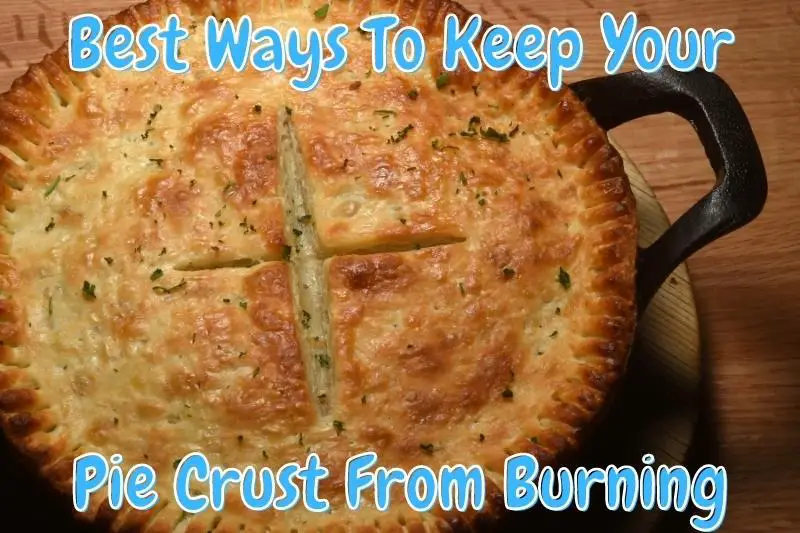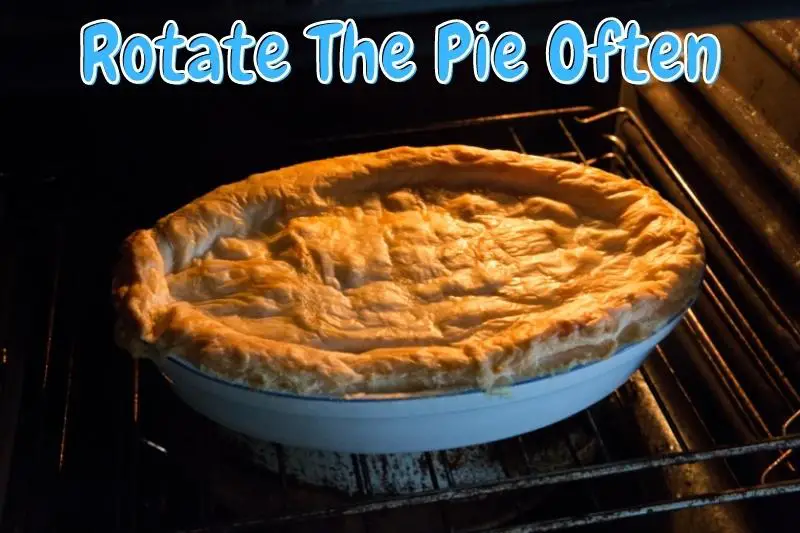This post contains affiliate links.
No one wants to eat a pie with a burnt crust. It’s frustrating when your dough starts to burn while you’re baking, and it can ruin the entire dessert. In this blog post, we will share four simple ways to prevent your pie crust from burning.
- Use Foil as a Crust Protector
- Use a Premade Pie Crust Shield
- Create Your Own Pie Crust Shield
- Rotate the Pie Often
Below, I will break down these methods of preventing a burnt pie crust while talking about the pros and cons of each method.
4 Simple Ways to Keep Your Pie Crust Dough from Burning
The best way to prevent your pie crust from burning is to use a pie crust protector. Pie crust protectors fit over the top of your pie crust and help prevent the dough from burning by deflecting direct heat from hitting the pie crust. You can find these at most kitchen stores or online.

I usually specifically look for Ceramic Pie Pans when baking pies. I recently came across a Set of Two Ceramic Pie Pans for Baking that work perfectly for baking pies in the oven with no problem. You can check out this Set of Ceramic Pie Pans on Amazon!
Keep reading as I share more simple ways to keep your pie crust from burning. Here are the 4 tried and tested ways:
Use Foil as a Crust Protector
Using foil works because it protects the dough from direct contact with the heat. To use the foil to protect your crust, do the following:
- Preheat your oven to the required temperature.
- Line a baking sheet with foil, then place your pie dough on the foil.
- Shape the foil around the dough, making sure that it’s not too tight, as the dough will expand as it bakes.
- Bake the pie according to the recipe instructions.
Below is a video I found showing the proper way to apply a crust shield made out of foil:
*Side Note: I recently wrote an article about How To Fix & Prevent Cracked Pie Crusts. This article talks about how to prevent pie crusts from cracking in the oven as well as how to fix it. You can check out this article here!
You can also use this method to cover areas of the crust that are getting too brown.
The advantages of using foil are that it’s inexpensive and easy to find. The downside is that it can be a bit fiddly to work with.
Use a Premade Pie Crust Shield
A premade pie crust shield is a circular or oblong-shaped piece of metal, silicone, or heat-resistant plastic that helps to prevent the edges of your pie crust from burning. They’re readily available online and at most kitchen stores.
I recently came across these Adjustable Pie Crust Shield Silicone Pie Protectors which protected my pies perfectly every time I used them. They’re made out of heat-resistant silicone material that will protect the pie crust edges from getting burnt. You can check them out on Amazon!
Here’s how to use a pie crust shield:
- Start by covering the edges of your pie crust with aluminum foil.
- Make sure the foil is large enough to extend beyond the edge of the crust by about 1 inch. You want to be sure that the entire crust is covered.
- Next, place the pie crust shield on top of the foil. If you’re using a metal pie crust shield, make sure that the shield is touching the foil. This will help to conduct heat and prevent burning.
- Bake your pie according to the recipe instructions.
- When the timer goes off, remove the pie crust shield and check the crust.
- Cover the edges with foil and continue baking if it’s starting to brown too much.
- Using a premade pie crust shield is better than using a pie crust shield because the premade shield is easier to remove from the hot pie.
- It’s also easier to place on the pie, and it offers a bit more coverage than a traditional shield.
| Pros of Using a Pie Crust Shield | Cons of Premade Pie Crust Shield |
|---|---|
| They’re easy to use | They can be more expensive than traditional pie crust shields |
| They’re readily available, and they’re quite neat | They might not fit your pie dish snugly |
| They help to keep the pie in the center to prevent spillage from the edges | They can be difficult to find in stores |
Create Your Own Pie Crust Shield
You can always make your own if you can’t find a premade pie crust shield that fits your pie dish. All you need is a circular piece of metal, silicone, or heat-resistant plastic that’s large enough to cover the entire circumference of the pie dish. I would recommend using parchment paper to create your shield.
Here’s how to make your pie crust shield:
- Cut a circular piece of parchment paper that’s large enough to cover the circumference of your pie dish.
- Fold the paper in half, then in half again. You should now have a quarter-circle shape.
- Cut a small slit in the center of the shield. This will help you to place the shield on the pie without touching the hot dough.
- Place the shield on the pie, making sure that the slit is in the center.
- Bake the pie according to the recipe instructions.
I always had the old-fashioned parchment paper roll in my kitchen but I recently came across a Box of Heavy Duty Flat Parchment Paper Sheets that work great without trying to rip the perfect sheet which never seems to work out. These sheets come in different sizes to fit your pans! You can check out these parchment sheets on Amazon!
One advantage of making your own pie crust shield is that you can make it any size that you want. This is perfect if you can’t find a premade shield that fits your pie dish snugly.
| Pros of Using a DIY Pie Crust Shield | Cons of Using a DIY Pie Crust Shield |
|---|---|
| They can be made to fit any size pie dish | Making your own shield are that it can be time-consuming, and you might not have the materials on hand |
| They’re inexpensive to make | It’s easy to misjudge the size of the shield and end up with one that’s too small or too large |
| They offer good coverage |
Rotate the Pie Often
Another simple way to keep your pie crust from burning is to rotate the pie often during baking. This will help the heat distribute evenly and prevent any area from getting too brown.
Here’s how to rotate a pie:
- Place the pie in the lower third of the oven.
- Bake for 20 minutes, then rotate the pie 180 degrees.
- Bake for an additional 20 minutes, then remove from the oven.
The good thing about this method is that you can integrate it with the other methods on this list. For example, you can cover the edges of the pie with foil, then rotate the pie during baking.
| Pros of Rotating a Pie | Cons of Rotating a Pie |
|---|---|
| It’s an easy way to prevent burning | It can be easy to forget to rotate the pie |
| It helps the heat to distribute evenly | You have to open the oven door, which can let heat escape |
| It’s a good way to check on the pie without opening the oven door | It’s not always necessary, depending on the recipe |
*By the way, I recently wrote an article about How To Fix A Runny Pie After It’s Baked. This article breaks down all the ways to fix the filling of a baked pie that is still runny. You can check out this article here!
How Do You Keep Pie Crusts from Burning Without Foil?
If you don’t want to use foil, you can bake the crust at the appropriate temperatures, use parchment paper or a silicone baking mat, and keep an eye on the pie crust. These are all effective ways to prevent burning without using foil.

Here is a detailed discussion of each method:
Bake at the Appropriate Temperatures
The appropriate temperature will vary according to the recipe, so be sure to follow the instructions carefully.
In general, pies should be baked at a moderate temperature (350°F/180°C) to prevent the crust from burning.
If you’re using a glass or ceramic pie dish, you might need to lower the oven temperature by 25°F/15°C to prevent the crust from over-browning.
Parchment Paper or Silicone Baking Mat
If you don’t want to use foil, you can line the pie dish with parchment paper or a silicone baking mat.
This will create a barrier between the dough and the pan, preventing the dough from coming into direct contact with the heat.
Keep an Eye on the Pie Crust
This is probably the most important tip on this list. No matter what method you use to prevent burning, you should always keep an eye on the pie crust while it’s baking.
This way, you can catch any problems early and prevent them from getting worse.
The best way to do this is to check the pie regularly, starting about 20 minutes into the baking time. If you see any areas that are getting too brown, you can cover them with foil or parchment paper.
*By the way, I recently wrote an article about The Best Ways To Prevent A Soggy Pie Crust. This article breaks down all the ways to make sure your crust does not come out soggy after it’s baked. You can check out this article here!
FAQs
How do you put tin foil on a pie crust?
As a general rule, rip two sheets of aluminum foil and bend them across the long way. Wrap the foil sheets around the top of the pie crust edges while bending them towards the bottom of the pie pan. Tuck the foil into the top of the pie pan so that it doesn’t fall while protecting the pie crust.
Why do pie crust edges burn?
As a whole, pie crust edges burn because they usually stick out of the pie pan which makes them exposed to direct heat throughout the whole baking process. If they’re not properly covered, or rotated often, the pie crust edges will begin to burn over time making them hard and inedible.
Why did the bottom of my pie burn?
In general, the bottom of your pie burned because it was baked on the bottom rack for too long. Pies need to finish their baking process on the middle rack since that is where the heat is evenly divided in the oven. Move the pie from the bottom rack to the middle rack once the pie crust is baked.
*By the way, I recently wrote an article about Which Oven Rack Should You Use To Bake A Perfect Pie. This article breaks down what happens when you bake a pie in all the oven racks and why one might be better than the others. You can check out this article here!
What do you put on the pie crust before baking?
Generally speaking, you need to put pie weights on the pie crust before baking it. Pie weights allow the crust to retain its shape during the baking process. This allows the crust to remain thick in height which allows it to hold any type of filling after it’s baked.
I’ve been using Ceramic Pie Weights for as long as I could remember and it saved my pie crusts on so many occasions. As a general rule, you should use about 2.2 lbs of pie weights for every 9-inch pie you make. I use these Ceramic Pie Weights that you can check out on Amazon!
